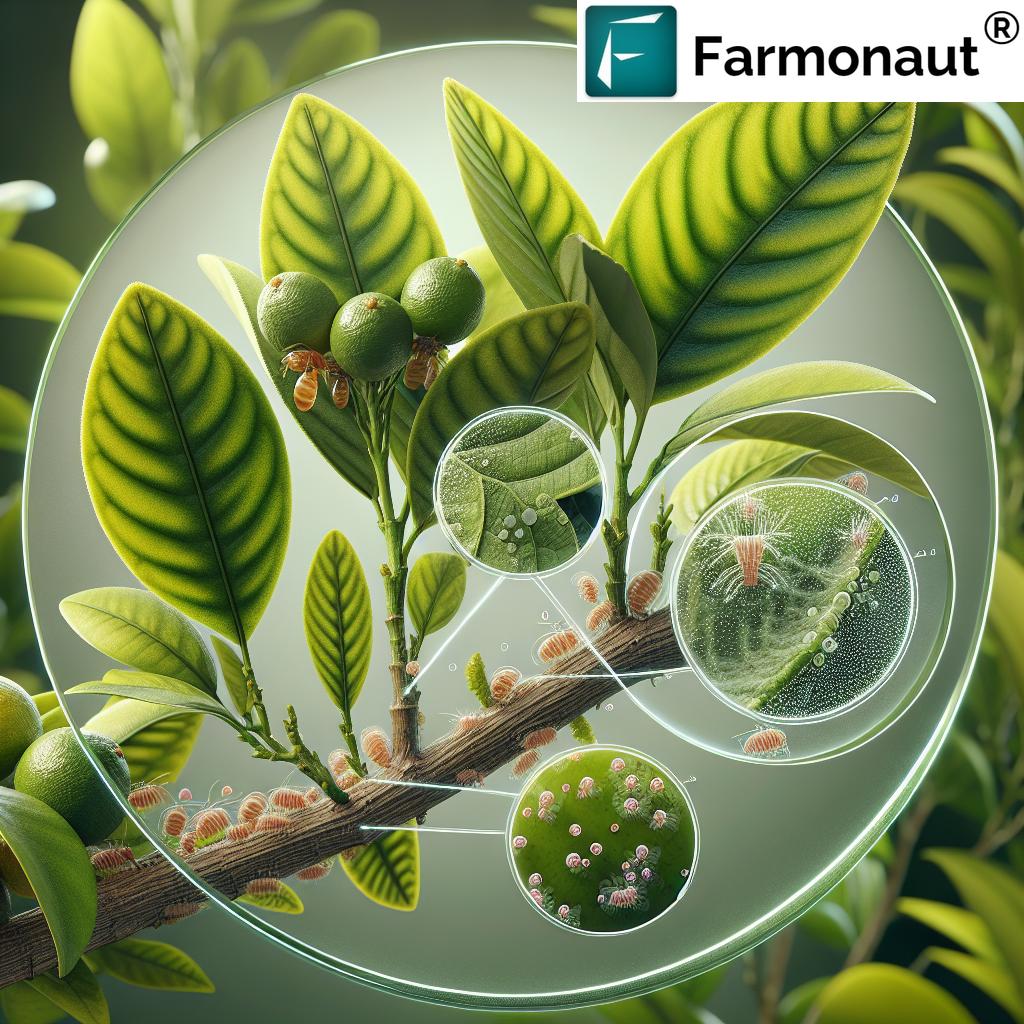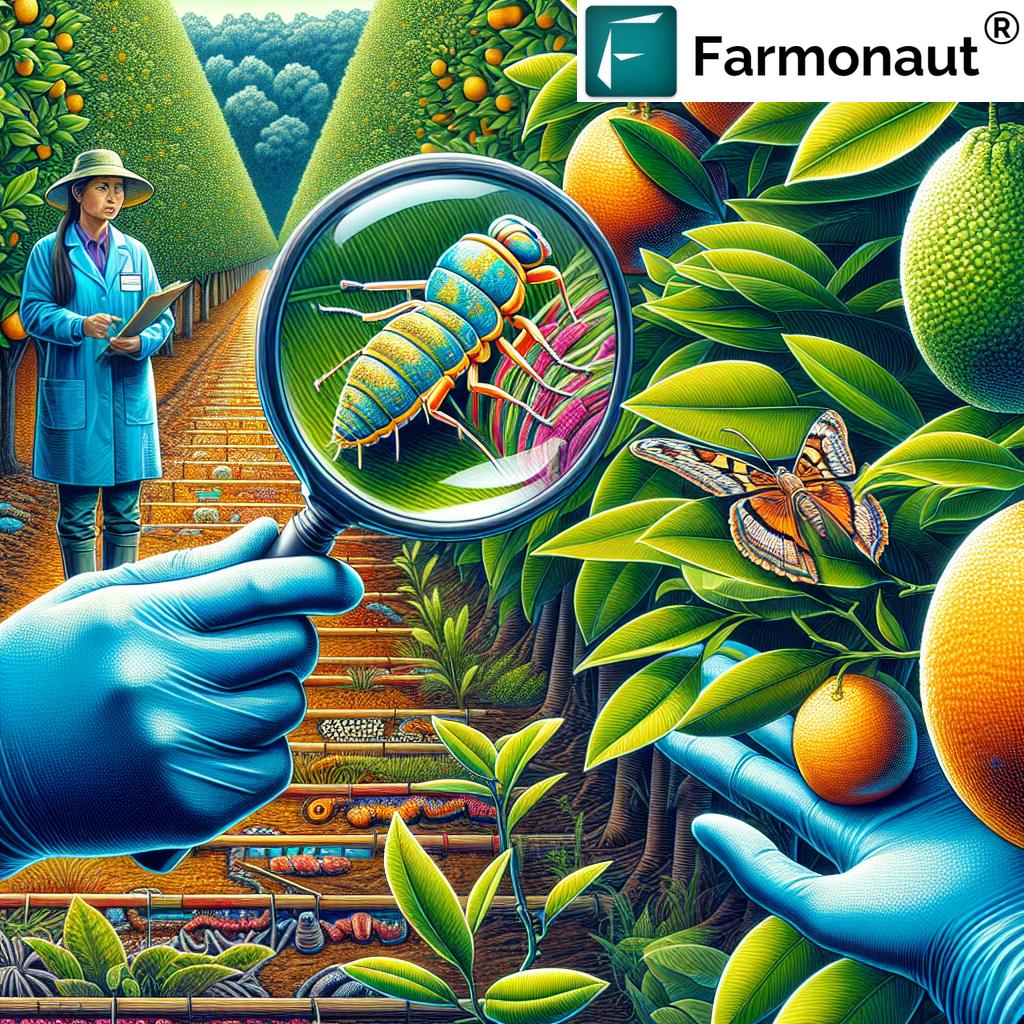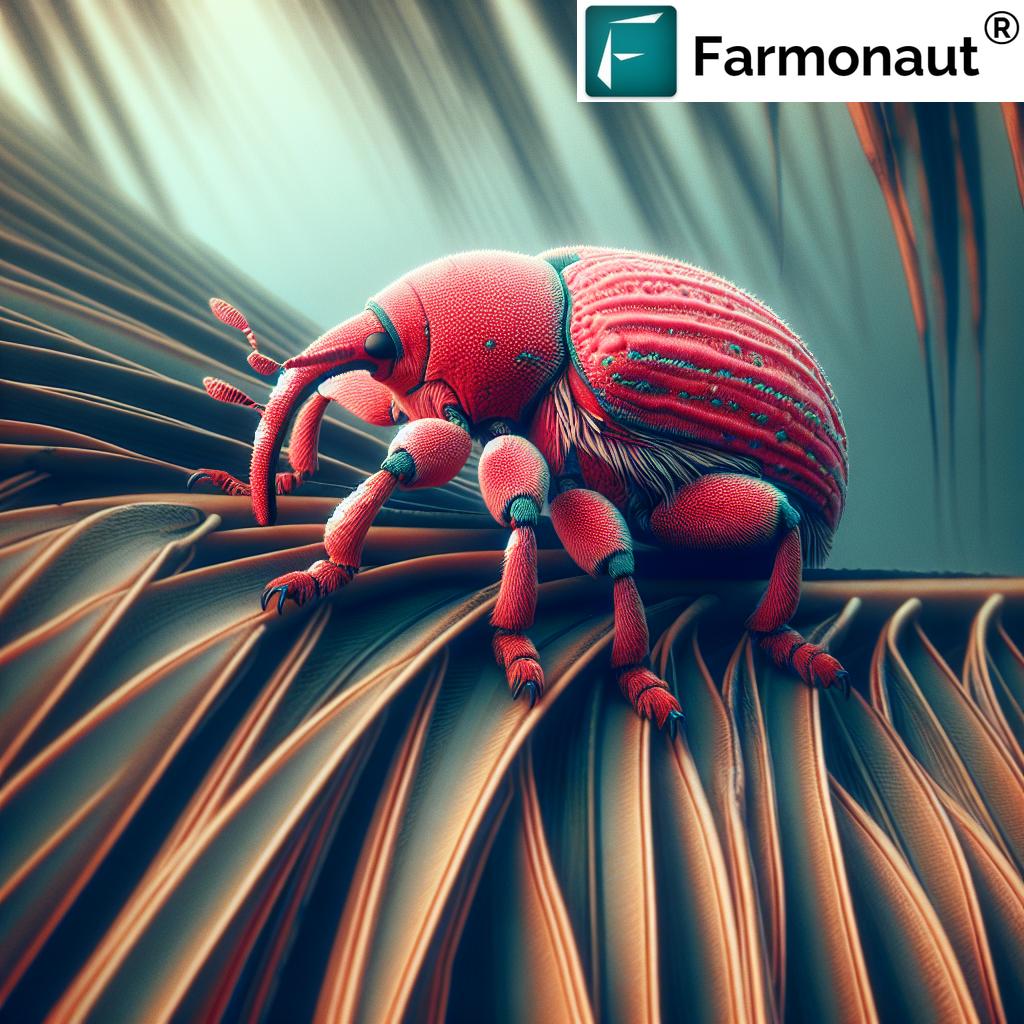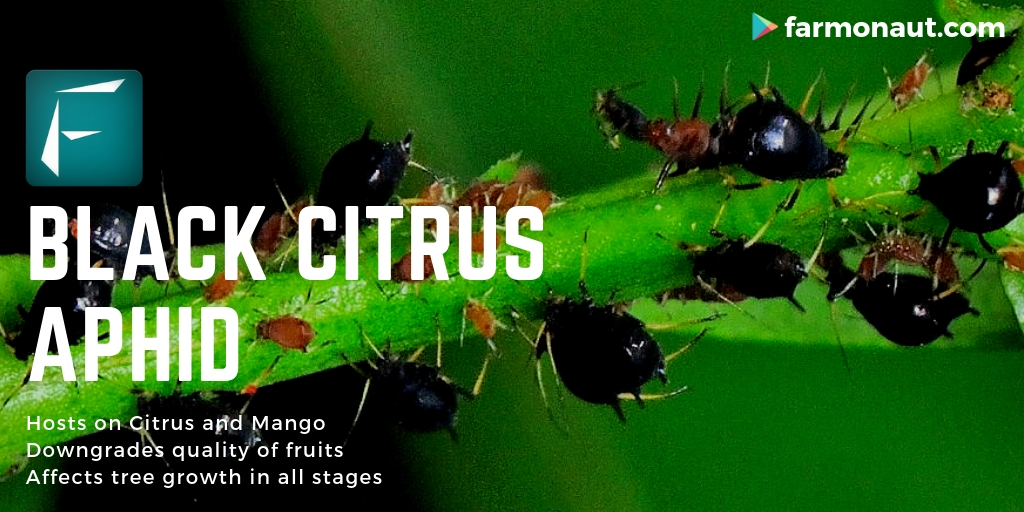Table of Contents
- Introduction: The Challenge of Citrus Pests
- Citrus Pest Trivia
- Common Insect Pests of Citrus Trees
- Citrus Pest Management Strategy Comparison Table
- Early Detection and Regular Monitoring of Citrus Pests
- Integrated Pest Management for Citrus: Strategy Overview
- 1. Cultural Controls for Citrus Pest Management
- 2. Biological Controls: Harnessing Natural Allies
- 3. Chemical Controls and Responsible Application
- 4. Physical and Mechanical Controls
- 5. Advanced Pest Surveillance and Technology
- 6. Organic and Eco-friendly Citrus Pest Control
- 7. Resistance Management and Orchard Health
- Practical Tips for a Healthy Citrus Orchard
- Key Trivia: Early Detection = Less Damage
- Farmonaut: Pioneering Precision Citrus Pest Management
- Frequently Asked Questions (FAQ)
- Conclusion
“Over 100 insect species can infest citrus trees, but 7 proven strategies can control most major pests effectively.”
Bugs on Citrus Trees: 7 Proven Pest Management Strategies
Citrus trees, renowned for their juicy fruits and aromatic oils, are fundamental to orchards worldwide but are also highly susceptible to a variety of insect pests. These pests not only compromise the health and productivity of citrus trees, but can threaten entire orchards if left unmanaged. From aphids and whiteflies to leafminers and scale insects, understanding their behaviors and deploying effective management strategies is crucial for any grower determined to maintain bountiful, healthy citrus crops.
In this comprehensive guide, we delve into the citrus pest management techniques that empower citrus growers to reduce insect pest populations, enhance early detection of citrus pests, and implement an integrated pest management for citrus approach. Armed with the latest research and practical solutions, you’ll learn how to identify, monitor, and control the common insect pests of citrus trees—protecting your trees and ensuring high-quality fruit yields year after year.
Common Insect Pests of Citrus Trees
The success of citrus tree pest control starts with common citrus pests identification. Below we summarize the key insect pests of citrus trees, their feeding behaviors, and impact on tree health and fruit quality:
-
Aphids (Toxoptera citricida – Brown Citrus Aphid):
- Target young buds and leaves by sucking sap.
- Cause leaf distortion, and are a vector for the tristeza virus—a notorious pathogen that can devastate citrus crops.
- Visible as clusters of small, soft-bodied, brown or black insects.
- Leads to aphids on citrus trees being a critical concern in citrus pest management.
-
Citrus Whiteflies (Dialeurodes citri):
- Tiny, moth-like insects that populate the undersides of leaves.
- They feed on sap and excrete honeydew, resulting in the emergence of sooty mold fungus that covers leaves and fruit, impacting photosynthesis and fruit quality.
-
Citrus Leafminers (Phyllocnistis citrella):
- Larvae of moths that create serpentine tunnels (leafminer damage) within young leaves—visible as silvery trails.
- These tunnels become entry points for pathogens.
- Early infestations primarily harm juvenile trees by reducing photosynthetic area and stunting growth.
-
Scale Insects (Aonidiella citrina – Yellow Scale, Aonidiella aurantii – Red Scale):
- Armored pests that attach to leaves, stems, and fruit.
- Feed by extracting sap, resulting in leaf yellowing, fruit discoloration, and—if left unchecked—tree death.
- Scale insects on citrus are a persistent management challenge.
-
Citrus Thrips:
- Small, slender insects that feed on tender leaves and fruit, causing scarring and deformities.
- Very damaging to young fruits—leading to reduced marketability.
-
Citrus Long-Horned Beetles (Anoplophora chinensis):
- Adults and larvae bore into trunks and branches, weakening the structural integrity of trees and causing potential tree death.
- Detection is often challenging as larvae remain hidden within the wood for extended periods.
Citrus Pest Management Strategy Comparison Table
| Citrus Pest | Common Symptoms | Estimated Damage Potential (% Yield Loss) | Recommended Control Strategy | Early Detection Methods | Effectiveness Rating (1-5) |
|---|---|---|---|---|---|
| Aphids (Toxoptera citricida) | Distorted leaves, sticky surfaces, presence on buds/leaves, virus transmission | Up to 25% | Biological & chemical controls; encourage ladybugs; monitor early | Inspect shoots for clusters; sticky cards; observe leaf curling | 4 |
| Whitefly (Dialeurodes citri) | Yellow leaves, sooty mold, honeydew, flying adults | Up to 15% | Cultural, sticky traps, biocontrol (wasps), selective insecticides | Monitor undersides of leaves; look for mold/honeydew | 4 |
| Leafminer (Phyllocnistis citrella) | Serpentine tunnels, curled young leaves, open wounds | Up to 20% | Prune and destroy infested leaves; pheromone traps; parasitic wasps | Check new leaves for mines/silvery trails | 3 |
| Scale (Aonidiella citrina/aurantii) | Armored bumps on stems/leaves, yellow leaf, fruit spots, dieback | Up to 30% | Biological predators (parasitic wasps), horticultural oils, pruning | Visually inspect stems/leaves; touch for scale presence | 4 |
| Thrips | Silvering, deformed fruit, scarring, distorted shoots | Up to 10% | Blue/yellow sticky traps, predatory mites, spot insecticides | Monitor young fruit/leaves, use hand lens | 3 |
| Long-Horned Beetle (Anoplophora chinensis) | Trunk holes, frass (wood dust), branch dieback | Up to 50% | Tree inspection, trunk banding, destroy infested wood | Check trunk/branch for holes or sawdust | 2 |
Accurate and timely detection of pest damage is critical. With Farmonaut’s large-scale farm management platform, growers can easily visualize pest-prone areas with satellite-based crop health maps, making regular citrus orchard pest monitoring more efficient and evidence-based.
Early Detection and Regular Monitoring of Citrus Pests
Early detection of citrus pests is at the heart of effective citrus pest management. Not only does it allow for prompt and precise intervention, but it helps prevent minor infestations from escalating into crop-threatening outbreaks.
Why Is Early Pest Detection Crucial?
- Reduces Yield Loss: Quick action can reduce potential yield loss by as much as 40% compared to delayed management.
- Minimizes Chemical Use: Catching infestations early means more targeted interventions—lowering reliance on broad-spectrum insecticides and preserving orchard health.
- Sustains Productivity: Protects both the current and future fruit harvests by preventing pest build-up.
What to Look For in Citrus Pest Monitoring?
- Discolored, deformed, or curled leaves
- Presence of insects on leaves, stems, or fruit
- Sooty mold fungus or honeydew residues
- Visible damage—tunnels, holes, scars, or necrotic spots
- Signs of dieback, fruit drop, or stunted growth
Smart Monitoring Technology
By utilizing remote-sensing data from Farmonaut’s satellite-based crop health monitoring, growers gain actionable insights into pest hotspots before severe damage occurs. The platform’s real-time visualization systems & AI-based advisory easily streamline citrus orchard pest monitoring—making it simple to plan IPM interventions in advance and safeguard your orchard’s health and productivity.
For technology integration, developers and large orchard managers can explore the Farmonaut Satellite API and study technical implementations via the Developer Docs to embed advanced monitoring and analytics into their pest management workflows.
Integrated Pest Management for Citrus: Strategy Overview
The most resilient approach to citrus tree pest control is through Integrated Pest Management (IPM), balancing cultural, biological, and chemical controls with continual monitoring and early detection. Let’s review the seven proven strategies that, collectively, form a robust IPM blueprint for healthy, productive orchards:
- Cultural Controls: Strengthening the tree’s own defenses and minimizing pest habitat.
- Biological Controls: Using the pest’s natural enemies for population suppression.
- Chemical Controls: Selective, well-timed, and minimal insecticide use.
- Physical/Mechanical Controls: Manual removal, trapping, and barriers.
- Advanced Pest Surveillance & Technology: Remote sensing, AI, and precision data for proactivity.
- Organic & Eco-Friendly Approaches: Environmentally safe, residue-free alternatives.
- Resistance Management & Orchard Health Optimization: Build lasting resilience and lower future risks.
1. Cultural Controls for Citrus Pest Management
Cultural controls are foundational for integrated pest management for citrus. The goal is to create an orchard environment that’s less favorable to insect pests and more conducive to tree health and productivity.
Key Practices
- Prune Regularly: Remove and destroy infested plant material to reduce pest populations.
- Optimize Irrigation and Fertilization: Avoid water stress or nutrient deficiencies that weaken trees and make leaves more susceptible to damage and pathogens.
- Manage Orchard Floor Cleanliness: Eliminate debris and weeds that serve as alternate hosts for aphids, whiteflies, or thrips.
- Implement Crop Rotation (if suitable): Disrupt pest life cycles and reduce habitat build-up.
Taking a preventative approach means fewer insecticide applications and long-term orchard health.
For larger plantations, Farmonaut fleet management solutions make scheduling and coordinating cultural control operations across blocks fast and efficient—saving both time and resources.
2. Biological Controls: Harnessing Natural Allies
Biological controls involve using living organisms to curb insect pest populations. Encouraging the orchard’s natural food web benefits sustainable citrus pest management.
- Predators:
- Ladybugs and lacewings are voracious consumers of aphids.
- Predatory mites target thrips and whitefly eggs.
- Parasitoids:
- Tamarixia radiata (wasp) parasitizes psyllids.
- Metaphycus spp. and Aphytis melinus combat scale insects on citrus.
- Pathogenic Fungi:
- Entomopathogenic fungi can infect and kill whitefly and scale populations.
Favored by minimal insecticide use and careful habitat management, these natural allies substantially reduce pest pressure—keeping orchards in ecological balance.
Learn how Farmonaut’s satellite crop health monitoring platform can pinpoint pest outbreak zones, helping growers and advisors direct beneficial releases for the greatest impact. Integrate via Farmonaut’s API for automated tracking and reporting.
3. Chemical Controls and Responsible Application
When pest pressure crosses the economic threshold or natural enemies alone aren’t sufficient, judicious use of chemical controls is warranted in citrus pest management.
- Choose Selective Insecticides: Targeted chemistry (like horticultural oils or systemic formulations) can suppress scale insects on citrus, aphids, leafminers, and whiteflies while sparing pollinators and natural enemies.
- Time Applications: Apply during the most vulnerable pest stages—such as when larvae hatch or adults emerge—to maximize effect and minimize resistance.
- Rotate Modes of Action: Alternating between active ingredients reduces pest adaptation and extends insecticide utility.
- Always Adhere to Label Instructions: Prevent environmental contamination and food safety risks by following local regulations and withholding periods.
Farmonaut’s AI advisory system can notify users of ideal spray windows based on detected crop health anomalies and local weather—ensuring optimized, evidence-based chemical interventions.
Leverage Farmonaut’s blockchain-based product traceability technology to document the use of pesticides and ensure full transparency for regulatory compliance and exports.
4. Physical and Mechanical Controls
These non-chemical practices offer simple, residue-free controls for citrus pests—particularly useful in organic and smallholder orchards.
- Hand Removal: Physically scraping off scale insects or egg masses from stems and leaves during periodic walks.
- Trapping:
- Sticky traps (yellow for whiteflies and thrips, blue for thrips) capture adults and act as early warning signs.
- Pheromone traps are effective for monitoring leafminers and beetles.
- Pruning: Removing infested shoots and branches to interrupt pest life cycles (especially leaf miner or scale insect outbreaks).
Combining these controls with cultural and biological tactics greatly increases overall effectiveness.
5. Advanced Pest Surveillance and Technology
Modern orchards can now harness precision agriculture technology for real-time tracking and forecasting of pest threats.
- Remote Sensing & Satellite Imagery: Detects plant stress, identifying hidden infestation hotspots for rapid response.
- Mobile Apps & Dashboards: Enable regular monitoring, automated scouting reports, and digital record-keeping.
- AI-Based Recommendations: Predict optimal intervention timing for each common citrus pest.
We at Farmonaut are proud to empower citrus growers with satellite-based, precision crop health monitoring and AI-driven pest management insights—making smart citrus pest management accessible to every orchard.
Explore Farmonaut’s large-scale farm management dashboard for quick analysis, zone-based interventions, and seamless team coordination.
6. Organic and Eco-friendly Citrus Pest Control
Where sustainability, residue reduction, and food safety are priorities, organic and eco-friendly citrus pest management is essential.
- Neem Oil: Disrupts insect feeding and life cycles for scale, whitefly, and some aphid species.
- Horticultural Soaps and Oils: Smother soft-bodied pests and act as a physical barrier against scale and aphids.
- Bacillus thuringiensis (Bt) & Other Biologicals: Target larvae such as leafminers or thrips—while sparing pollinators and predatory insects.
- Encourage Biodiversity: Planting companion species and providing habitats for beneficial insects.
These approaches, when combined with monitoring and cultural controls, decrease pest pressure while protecting pollinator and soil health.
Support healthy, sustainable citrus production with Farmonaut’s carbon footprinting dashboard—track the reduction of pesticide emissions and promote environmentally friendly practices in your orchard.
7. Resistance Management and Orchard Health
Persistent or repetitive pesticide use can breed insect resistance. Managing this risk is vital for orchard sustainability—by rotating chemical classes, using precise applications, and always integrating non-chemical tactics.
- Varietal Selection: Choose citrus cultivars less susceptible to major pests.
- Maintain High Tree Vigor: Support rapid recovery from injury and enhanced ability to withstand pest outbreaks.
- Plan Rotational or Intercropping Schemes: Dilute pest-specific habitat and foster agro-ecosystem balance.
By focusing on orchard health optimization, you build resilience against future threats—keeping both insect pests and pathogen risks in check.
“Early pest detection can reduce citrus crop losses by up to 40% compared to delayed intervention.”
Practical Tips for a Healthy Citrus Orchard
- Schedule regular orchard walks for hands-on scouting—check both upper and lower leaf surfaces and trunk bases.
- Keep detailed pest monitoring records—documenting date, pest type, infestation intensity, and control actions.
- Map pest outbreaks over time to recognize patterns and enable zone-specific actions (digitally with Farmonaut or manually).
- Rotate cultural, biological, and chemical tools for the most effective pest management outcomes.
- Educate staff and workers on common citrus pests identification and disease symptoms.
- Review orchard health via Farmonaut’s satellite crop monitoring app regularly, or automate notifications and advisories with their AI-based system.
Farmonaut: Pioneering Precision Citrus Pest Management
At Farmonaut, our mission is to make advanced, data-driven citrus pest management available and affordable for every grower—regardless of orchard size or location. By integrating real-time satellite-based AI technologies, we help you effortlessly monitor crop health, forecast insect infestations, and optimize pest controls for higher fruit yield and improved sustainability.
Satellite Crop Health Monitoring:
Detect subtle plant stress early for rapid intervention and early detection of citrus pests.
AI-Based Advisory:
Get personalized, real-time advisories on pest risk periods, weather, and management recommendations—right in your app dashboard.
Product Traceability:
Using blockchain, create full input and output transparency to substantiate exports and regulatory compliance—visit Farmonaut Traceability.
Resource & Fleet Management:
Assign and track pest control operations efficiently across your holdings. Explore more with Farmonaut Fleet Management.
Carbon Footprinting:
Benchmark and reduce emissions from pest control activities—pivot to sustainable, eco-conscious orchard management with Farmonaut Carbon Footprinting.
Crop Loan & Insurance:
Secure your investment with satellite-verified field data for insurance claims and crop loans via Farmonaut’s Crop Loan & Insurance solutions.
Frequently Asked Questions (FAQ) on Citrus Pest Management
What are the most common insect pests found on citrus trees?
The main insect pests include aphids (Toxoptera citricida), whiteflies (Dialeurodes citri), leafminers (Phyllocnistis citrella), scale insects (Aonidiella citrina & aurantii), citrus thrips, and citrus long-horned beetles (Anoplophora chinensis).
Why is early detection of citrus pests so important?
Early detection of citrus pests enables growers to intervene before infestations cause significant damage. Early action can prevent yield loss, reduce chemical use, and maintain overall orchard health.
How can I tell if my citrus trees are infested?
Common signs include deformed or discolored leaves, sticky honeydew or sooty mold on leaves or fruit, visible pests on plant surfaces, and holes or tunnels in leaves and bark.
Can biological controls replace insecticides entirely?
While biological controls can dramatically reduce pest pressure, complete elimination of insecticides is rarely practical—especially in high-pressure situations. Integrate biological, cultural, and chemical controls in a comprehensive IPM program for the most reliable results.
How does satellite monitoring help with pest management?
Satellite monitoring, like Farmonaut’s platform, detects crop stress remotely, allowing for early identification of pest-affected orchard zones. This enables precise, targeted responses and often reduces the need for widespread chemical treatments.
What is the best way to manage scale insects on citrus?
Scale insects on citrus can be managed using natural predators (like parasitic wasps), horticultural oils, and regular monitoring. Pruning heavily infested branches also helps reduce populations.
Are there eco-friendly options for citrus pest management?
Yes—neem oil, horticultural soaps, predatory insects, and targeted use of biological insecticides are all effective and environmentally responsible options.
Conclusion: Invest in Healthy Citrus Orchards
Citrus orchards face an array of insect pest threats—but with integrated pest management for citrus, early detection, and the right combination of cultural, biological, and chemical controls, growers can protect their crop, maximize fruit quality, and ensure long-term orchard health.
Farmonaut provides modern, affordable tools that help citrus growers deploy precision, tech-driven solutions for their citrus pest management challenges. By blending centuries-old wisdom with the power of AI and satellite analytics, we empower you to safeguard your orchards—today and for seasons to come.
Empowering citrus growers to thrive—with knowledge, technology, and smart, sustainable management!











